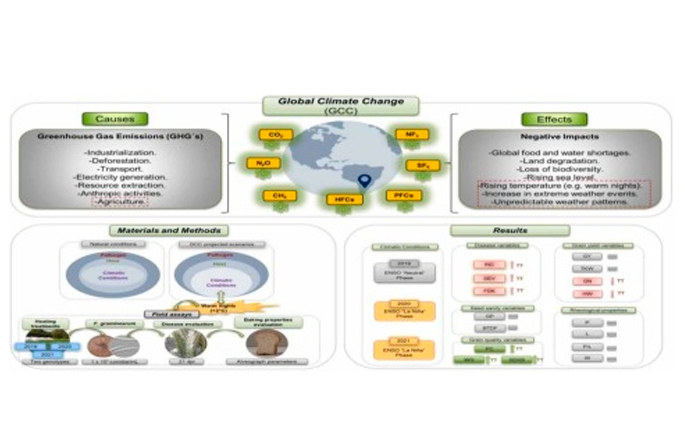Field Crops Research, Volume 314, 15 June, 2024
Highlights
- Global climate change (GCC) worldwide affects agriculture and food safety.
- Fusarium Head Blight (FHB) and warm nights could increase under climate change scenarios.
- FHB occurrence will increase under GCC scenarios, negatively impacting grain quality and yield.
- No significant variations were reported regarding rheological properties under GCC conditions.
- The study of stress combinations would be relevant to designing GCC mitigation strategies.
Abstract
Context
Global climate change (GCC) is one of the most challenging concerns for humanity in the coming decades. Agricultural production and food safety are not exempt from this phenomenon. The occurrence of warm nights is projected to increase by the end of the century, which could modify the occurrence of fungal diseases such as Fusarium Head Blight (FHB). Understanding how GCC can affect plant-pathogen interactions could help predict negative impacts in cereal crops under field conditions.
Objective
The present study aimed to evaluate the effect of warm nights (+3°C) on the pathosystem F. graminearum-bread wheat under field conditions. Specifically, this work focused on the combination of biotic stress (FHB infection) and abiotic stress (warm nights) on the behaviour of commercial wheat genotypes.
Methods
Field assays were carried out during three consecutive growing seasons (2019, 2020, and 2021) under field conditions. Two commercial wheat genotypes with contrasting baking quality were tested under GCC projected conditions. During the susceptibility period for FHB infection, three treatments were applied: natural conditions, inoculated with F. graminearum, and temperature treatment + F. graminearum. After 21 days post-inoculation, disease parameters were registered, while after harvest, grain yield, grain quality, and rheological properties were evaluated.
Results
Warm nights increased disease incidence (up to 16%), disease severity (3% on average), and FDK (0.12%) depending on the year and genotype. These changes negatively impact on grain number m-2 (≈4%) and hectolitre weight (up to 1.32 hL-1). Moreover, grain quality parameters such as protein content (up to 1.20%), wet gluten (≈2%), and SDSS (≈3%) were higher when the night temperature was increased by 3°C. No significant changes were reported regarding rheological properties, although a change to a better baking quality could occur depending on the genotype and the year.
Conclusions
Warm nights could increase FHB pathogenicity under GCC scenarios, affecting grain yield and grain quality parameters. However, the impact of warm nights on rheological properties remains unclear. The present study is the first approach to the impact of warm nights on F. graminearum-bread wheat, focusing on commercial genotypes and their potential impact on rheological properties. The information generated could be useful for scheduling promising plant breeding programmes to mitigate the negative impact of GCC on wheat crops.
Implications
Warm nights could increase the negative impact of FHB on wheat crops under field conditions, seriously compromising food safety under GCC.

Graphical Abstract
